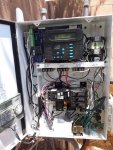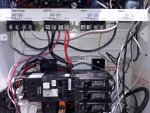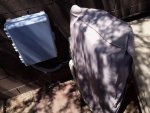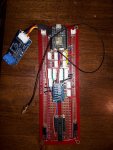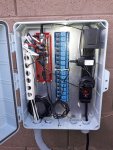9) Why So Many Pressure Sensors?
Why do I have four PSI transducers…don’t systems usually have just one… on the filter?
This was an idea that I thought about during the time I was working on my In-Floor-Cleaning-System (IFCS) thread. I realized how important PSI was for my IFCS. But, I have also thought about some other ideas and would love to hear any input on issues/expansion of these ideas. I will be testing some of these ideas out and figuring out whether I want to move forward with them and/or what kind of response/alert they should automatically generate.
To recap, I have four PSI sensors throughout my system…one on the pump vacuum side, one on the pump pressure side, one on the filter, and one on (actually close) to my IFCS manifold. What good are they? Here is where I am headed with these.
Pump Vacuum Side
- Give alerts that the skimmer basket needs clearing
- Give alerts that the pump basket needs clearing
- Monitor the position of my skimmer/main drain “valve”…the PSI will indicate where the suction is drawing “from”. This is a bit complicated because I actually don’t have a valve there, I have what’s referred to as a “spaceship diverter” in my skimmer. I won’t get into details here, but I have a method to control where I suction the water from (skimmer or main drain). This gauge will monitor the "success" of that mechanism.
Pump Pressure Side
This is probably redundant to the “filter” pressure gauge, but it was an existing spot that I could plug a transducer in. My only idea to date has been to use the pump vacuum side pressure and the pump pressure side pressure to calculate a dynamic GPM.
I have a FlowVis in my system and would compare this dynamic calculation to that given by the FlowVis. If the dynamic gpm calculation is close to the FlowVis, than I will use it, dynamically, to record GPM numbers.
I realize that “knowing your gpm” is not a popular topic for this site. But for me, it has been invaluable. You see, the only way to calculate actual Energy Factor of our very expensive VSPs is to know the GPM and the watts of the VSP at any given RPM. Just having a VSP and operating at a low RPM or a low watts value doesn’t mean you are taking full advantage of it. Something as simple as having the wrong size wall return nozzles can seriously impact your energy efficiency…and you may never know without checking.
Anyway, that’s what I have found out, and why I like to know my GPM.
GPM is also important for systems with IFCSs like mine because of another reason…it’s a dirty word: TURNOVER. Turnover is actually somewhat important for the operation of most IFCSs. The popups stir up the dirt/debris and must “filter” it out. Turnover is a part of that equation.
Filter Pressure Gauge
Obviously when a filter gets dirty, the filter pressure increases. This will give an indication when your filter needs cleaning. Every advanced automation system and their mother should have this one, haha.
In-Floor-Cleaning-System (IFCS) Manifold
Most don’t have IFCSs, of course, but I really like mine, and mine is very cheap to run. Here is what I am going to use this PSI gauge to determine:
- Monitoring cleaning cycle time: how long it takes popups to completely rotate around the pool once. Changes in this value can indicate a problem with the gear mechanism.
- Monitoring individual zone pressures. Occasionally, I have a popup loosen and come out, this PSI gauge will immediately give an indication that this has occurred.
- Monitoring pressure at the IFCS manifold, make sure it is at my target(s) for popup operation
- Controlling pressure at my IFCS manifold. I’m considering experimenting with feedback from this PSI gauge to “tweak” a valve to any intermediate spot (not fully open or fully closed). I have found a significant advantage for my IFCS by doing this manually (a one-shot permanent valve tweaking), and am considering expanding this method to allow it to be used for more than one IFCS manifold pressure “target” AND be done automatically.
GENERAL
In general, knowing the pressures, rpm, watts for specific operating conditions/configurations is something that can be “compared” to known good values. Deviations by more than TBD percent/value on a particular parameter could indicate a problem, perhaps serious, in the system. I am planning on setting up a table of these values for each common operating condition to use as a comparison.
My EcoStar pump failed last year and I don’t know how many days it was actually failing before I found it. It thought it was running (and if my stenner pumps had been installed at the time, they would have thought so too), but it wasn’t. Monitoring ANY PSI parameter in a system probably would have caught that problem.
Of course, catastrophic failures like pipes breaking can also be detected immediately. The system can easily be shutdown.
Anyway, that’s where I am headed with some of this PSI sensor information. Is it overkill? Possibly, but as I have said many times: I am in this for fun, and to me this kind of experimenting IS fun, haha. Additional PSI transducers are also incremental in effort/cost...in the overall picture, it costs about the same to implement one OR four.
... if so I want the LCARS theme? Sorry its the geek in me.
...





